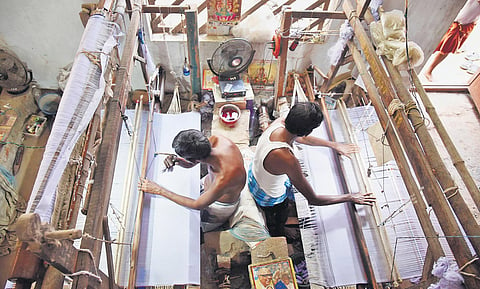

CHENNAI: Anakaputhur was once a renowned hub and a thriving weaving village. There were close to 5,000 handloom mills here and every family owned close to four. Now, the number of mills has dwindled to 200 and for the 100-odd weaver families that reside in the suburb, there is a looming uncertainty pervading their livelihoods and future. Even before the coronavirus and the eventual lockdown came into place, we’ve had our fair share of challenges.
In the late 1960s and early 1970s, we were known for our nine-yard checkered fabric, known as the ‘Madras Handkerchief’, which was imported to Nigeria. But due to the coup, followed by the civil war and the eventual ban on imports in Africa, we incurred a huge loss. More recently, during the 2015 Chennai floods, we lost fabric and equipment worth close to `45 lakh. Several promises were made by the state government to help us revive our livelihoods but we were only met with a series of disappointments.
Over the years, despite the adversities and lack of facilities, we have tried to reinvent ourselves and put us on the global map. Fifteen years ago, during one such period, when we were on the brink of losing hope, I drew inspiration from mythology. In the Ramayana, there are mentions of Sita spinning a sari out of banana fibre and I thought, why not we adopt it?
The banana plant is versatile and every part of it can be put to use. So, along with the weavers in our cluster, I decided to tap into this and produce fabric out of the banana stem. What started as a simple idea soon grew and the weavers in our cluster began spinning and dyeing fabric made of the vazhai maram. It’s a very labour-intensive process but is 100 per cent sustainable. The fibre is processed, treated with medicinal herbs and plants and is dyed with organic colours derived from turmeric and indigo. Women form a major chunk of our cluster and today, we have grown to produce handlooms out of 25 natural fabrics including banana, bamboo, aloe vera and vetiver.

Eight years ago, the government of India, as part of its schemes for weavers and MSMEs, agreed to provide us with the equipment to make the weaving process time and cost-efficient (on average, it takes five days for a weaver to complete on sari). But here, in the suburb, we don’t have enough space to set it up. Despite several appeals to the government for a dedicated village for the Anakaputhur weaving community, the response has been bleak. When industries are sanctioned acres of land, why can’t we get a small piece of land?
Before the pandemic, our livelihoods, if not flourishing, was at least not pathetic. On average, we used to sell close to 100 saris and over 200 metres of natural fibre. Now, with the lockdown and transportation ban, it has been difficult and impossible for us to procure the yarn (which we get from a bordering district in Andhra Pradesh) and to sell/even send the saris through courier. It has completely jolted our livelihoods.
We have an online portal called Ananafit for our products. Though several people have shown interest in buying them, we are unable to deliver it. How can we? We weavers are not even given identity cards and our request for e-passes keeps getting cancelled.
No relief has been provided to those in the cluster by the government nor by city-based NGOs. In April and early May, two Bengaluru-based NGOs that work for the welfare of handloom weavers came forward to provide us with essentials like rice, dal and oil. But that was all. Kannule ratham mattum dhan varale (We have only yet to shed blood from our eyes). The situation is otherwise extremely grim. Most of the third generation weavers in the cluster are over 50 years of age and we aren’t equipped with the skills to do any other work. We can’t even work as daily wage labourers as most of us are in our silver years.
Many artisanal weavers have started abandoning their mills due to poverty and in the search for other job prospects. But for those like me, this job is our saami (god) and we will never leave it. All we need is a helping hand to keep our mills running.
Weaves that wow
The cluster made it into the Limca Book of Records in 2011, for weaving a sari using 25 different fibres.
A sari costs anywhere from Rs 1,700 to 7,000
(and upwards)
Fifty-seven-year-old C Sekar is the president of the Anakaputhur Jute Weavers Association and a third-generation weaver. (As told to Roshne Balasubramanian)
For details, visit Facebook page Ananafit/website www.ananafit.com . To contribute, call C Shekar 7010915622